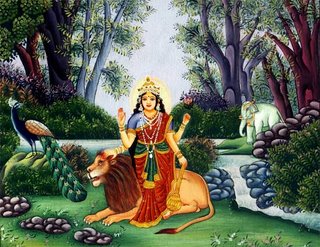The Forms of Sanskrit Technology: Shruti

Usually when someone describes the sacred scriptures of India, they begin with the Vedas. But instead, backwardly, I've wound down -- like the inside of a conch shell -- to the holy core of India's spirituality.
Only now after having mused on the first line of Patanjali's Yoga Sutras...the sweet Lord's Song (Bhagavad Gita), Upanishads and the Forest Wisdom (Aranyakas) they're based on...only now do I feel like shifting my thoughts to Shruti.
Because Shruti is the primordial, first, and initial impulse of knowledge, people like to discuss it at the outset. But I've gone in a reverse direction. I've shown how everything is based on something that came before. (In Sanskrit, this is described as parampara, "one after another" and it is the word for "lineage.")
The forest wisdom inspired the Upanishads and its methods....which inspired the dialog between Krishna and Arjuna (the penultimate Guru and Disciple)...which described a method (a Yoga) compiled into potent sound bytes of truth (sutras) by Patanjali.
At the origin of all this unfolding knowledge is the Shruti, the primordial sounds of truth.
Shruti means "that which is heard."
Logically, we hear with our ears. But really ears are only the instrument through which we hear, but they don't determine what we hear. Sounds travel through the space element until they are close enough to enter our ears. The sound stimulates a nervous system reaction -- an automatic sequence of pre-wired events that transport sound to the brain, which "hears" it.
Of course there are many sounds bombarding our ear instruments every moment, so the brain chooses what it wants to "hear."
The rsis (whose title interestingly translates as "seers," though they were first "hearers") wanted to hear the sounds that animate all life. But first they had to become very quiet themselves. If there is too much noise in your mind, you can't hear properly. It's so noisy in there that the brain, over-saturated with sound, literally pushes out any new input.
(I think this is why a lot of old people don't listen. It's not that they can't hear, they won't hear. Packed with a lifetime of noise, their heads simply can't hold any more sound.)
The rsis knew that silence was the precondition that allowed for deep listening. To be really silent they had to shut down the part of the mind that analyzes. (The intellectual part of the mind that dismisses the innocence of pure listening with identifications such as, "Oh, that's a red-wing black bird's song....That's the song they sing in the Spring during mating season...I like red-wing black birds...They live near water," and so on.)
Just listening to the bird's song with no preconceived idea to distort the experience is shruti.
All knowledge arises out of truly hearing something at its essence -- not from all the categories we heap on the things we choose to hear.
This kind of hearing cannot be described with words, but it can be replicated in song. This is why the Shruti or the Vedas are arranged as "hymns." Whatever the rsi heard, he recorded it in a song. If, for example, he heard the sounds of the sky getting ready to burst into the Dawn, he sang them to himself.
In this way, the rsi identified the sounds of creation with his own body. When he sang Creation's hymns in its own perfect melody and rhythm, he became united with the whole.
The outside world and his inner heart became one, complete, song.


